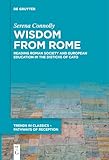Wisdom from Rome : Reading Roman Society and European Education in the Distichs of Cato / Serena Connolly.
Material type: TextSeries: Trends in Classics – Pathways of Reception ; 8Publisher: Berlin ; Boston : De Gruyter, [2022]Copyright date: ©2022Description: 1 online resource (IX, 250 p.)Content type:
TextSeries: Trends in Classics – Pathways of Reception ; 8Publisher: Berlin ; Boston : De Gruyter, [2022]Copyright date: ©2022Description: 1 online resource (IX, 250 p.)Content type: - 9783110788846
- 9783110789614
- 9783110789492
- online - DeGruyter
- Issued also in print.
| Item type | Current library | Call number | URL | Status | Notes | Barcode | |
|---|---|---|---|---|---|---|---|
 eBook
eBook
|
Biblioteca "Angelicum" Pont. Univ. S.Tommaso d'Aquino Nuvola online | online - DeGruyter (Browse shelf(Opens below)) | Online access | Not for loan (Accesso limitato) | Accesso per gli utenti autorizzati / Access for authorized users | (dgr)9783110789492 |
Browsing Biblioteca "Angelicum" Pont. Univ. S.Tommaso d'Aquino shelves, Shelving location: Nuvola online Close shelf browser (Hides shelf browser)
Frontmatter -- Acknowledgements -- Contents -- List of Figures -- Introduction -- Part I: The Distichs and Paraenesis -- 1 The Distichs -- 2 Ancient Wisdom -- 3 Style -- Part II: Content and Context -- 4 Friendship -- 5 Money -- Part III: Reception -- 6 Legere et intelligere: Editions and Commentaries for Schools and Homes -- 7 Translations and Transformations -- Conclusion -- Appendix: Selected Translations of DC 3.24 -- Works Cited -- Index of Subjects -- Index Locorum
restricted access online access with authorization star
http://purl.org/coar/access_right/c_16ec
For about one thousand years, the Distichs of Cato were the first Latin text of every student across Europe and latterly the New World. Chaucer, Cervantes, and Shakespeare assumed their audiences knew them well—and they almost certainly did. Yet most Classicists today have either never heard of them or mistakenly attribute them to Cato the Elder. The Distichs are a collection of approximately 150 two-line maxims in hexameters that offer instructions about or reflections on topics such as friendship, money, reputation, justice, and self-control. Wisdom from Rome argues that Classicists (and others) should read the Distichs: they provide important insights into the ancient Roman literate masses’ conceptions of society and their views of relationships between the individual, family, community, and state. Newly dated to the first century CE, they are an important addition and often corrective to more familiar contemporary texts that treat the same topics. Moreover, as the field of Classics increasingly acknowledges the intellectual importance of exploring the reception of Classical texts, an introduction to one of the most widely read ancient texts for many centuries is timely and important.
Issued also in print.
Mode of access: Internet via World Wide Web.
In English.
Description based on online resource; title from PDF title page (publisher's Web site, viewed 02. Mai 2023)









